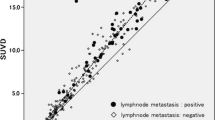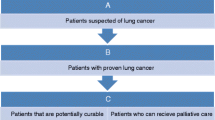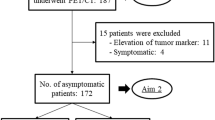Abstract
Objectives
We compared the diagnostic value of fluorine-18-fiuorodeoxyglucose positron emission tomography (FDG-PET) with that of computed tomography (CT) following radiofrequency ablation (RFA) of inoperable recurrent or metastatic cancers in the lung.
Methods
Twelve patients (9 males and 3 females; 5 had recurrent lung cancer and the other 7 had metastatic nodules from a variety of primary cancers) were treated by RFA for 17 pulmonary nodules. FDG-PET was performed before and 2 months after RFA, and the mean standardized uptake value (SUV) was calculated. The response evaluation was based on the percent reduction relative to the baseline and the absolute values of SUV on FDG-PET performed at 2 months after RFA. We compared the response evaluations made based on findings of FDG-PET and CT at 2 and ≥6 months (mean 10.2) after RFA.
Results
The percent reduction in uptake at 2 months was significantly lower in nodules considered progressive (69.6± 18.6%) than nonprogressive disease (38.7 ± 12.5%; p < 0.01) based on CT findings at >6 months after RFA. The absolute SUV at 2 months was significantly higher in nodules considered progressive (2.61 ±0.75) than nonprogressive disease (1.05 ±0.67; p<0.01) based on CT findings at ≥6 months post-RFA.
Conclusion
Although our pilot study comprised few cases of various histopathological types of cancers in the lung, the results suggest that FDG-PET could predict regrowth on subsequent follow-up CT. Regrowth could be diagnosed earlier by FDG-PET than by CT, and nodules with residual uptake and with <60% reduction of uptake relative to baseline on FDG-PET at 2 months after ablation might require additional therapy.
Similar content being viewed by others
References
Gazelle GS, Goldberg SN, Solbiati L, Livraghi T. Tumor ablation with radio-frequency energy.Radiology 2000; 217:633–646.
Dupuy DE, Goldberg SN. Image-guided radiofrequency tumor ablation: challenges and opportunities—part 2.J Vasc Interv Radiol 2001; 12:1135–1148.
Curley SA, Izzo F, Ellis LM, Nicolas VJ, Vallone P. Radiofrequency ablation of hepatocellular cancer in 110 patients with cirrhosis.Ann Surg 2000; 232:381–391.
Livraghi T, Goldberg SN, Lazzaroni S, Meloni F, Ierace T, Solbiati L, et al. Hepatocellular carcinoma: radio-frequency ablation of medium and large lesions.Radiology 2000; 214:761–768.
Rossi S, DiStasi M, Buscarini E, Quaretti P, Garbgnati F,Squassante L, et al. Percutaneous RF interstitial thermal ablation in the treatment of hepatic cancer.AJR Am J Roentgenol 1996; 167:759–768.
Gervais DA, McGovern FJ, Arellano RS, McDougal WS, Mueller PR. Renal cell carcinoma: clinical experience and technical success with radio-frequency ablation of 42 tumors.Radiology 2003; 226:417–424.
Rosenthal DI, Springfield DS, Gebhart MC, Rosenberg AE, Mankin HJ. Osteoid osteoma: percutaneous radio-frequency ablation.Radiology 1995; 197:451–454.
Dupuy DE, Zagoria RJ, Akerley W, Mayo-Smith WW, Kavanagh PV, et al. Percutaneous radiofrequency ablation of malignancies in the lung.AJR Am J Roentgenol 2000; 174:57–59.
Steinke K, Habicht JM, Thomsen S, Soler M, Jacob AL. CT-guided radiofrequency ablation of a pulmonary metastasis followed by surgical resection.Cardiovasc Intervent Radiol 2002; 25:543–546.
Herrera LJ, Fernando HC, Perry Y, Gooding WE, Buenaventura PO, Christie NA, et al. Radiofrequency ablation of pulmonary tumors in nonsurgical candidates.J Thorac Cardiovasc Surg 2003; 125:929–937.
Oyama M, Matsuoka T, Toyoshima M, Okuma T, Yamamoto A, Sakai Y, et al. Usefulness of computed tomography for evaluating recurrence after radiofrequency ablation.JJLC Jpn J Lung Cancer 2003; 43:247–252.
Steinke K, King J, Glenn D, Morris DL. Radiologic appearance and complications of percutaneous computed tomography-guided radiofrequency-ablated pulmonary metastases from colorectal carcinoma.J Comput Assist Tomogr 2003; 27:750–757.
Sewell PE, Jackson MS, Vance RB, Wang YD. Assessing radiofrequency ablation of non-small cell lung cancer with positron emission tomography (PET) [abstract].Radiology2000; 217(suppl):334.
Akeboshi M, Yamakado K, Nakatsuka A, Hataji O, Taguchi O, Takao M, et al. Percutaneous radiofrequency ablation of lung neoplasms: Initial therapeutic response.J Vasc Interv Radiol 2004; 15:463–470.
Dupuy DE, Mayo-Smith WW, Abbott GF, DiPetrillo T. Clinical applications of radio-frequency tumor ablation in the thorax.RadioGraphics 2002; 22:S259–269.
Suh RD, Wallace AB, Sheehan RE, Heinze SB, Goldin JG. Unresectable pulmonary malignancies: CT-guided percutaneous radiofrequency ablation—Preliminary results.Radiology 2003; 229:821–829.
Matsuoka T, Toyoshima M, Nakamura K, Yamada R, Inoue K, Lubinski A. Percutaneous radiofrequency ablation for lung tumors.Cardiovasc Intervent Radiol 2001; 24 (suppl): 202.
Yasui K, Kanazawa S, Sano Y, Fujiwara T, Kagawa S, Mimura H, et al. Thoracic tumors treated with CT-guided radiofrequency ablation: initial experience.Radiology 2004; 231:850–857.
Nishida T, Inoue K, Kawata Y, Izumi N, Nishiyama N, Kinoshita H, et al. Percutaneous radiofrequency ablation of lung neoplasms: A minimally invasive strategy for inoperable patients.J Am Coll Surg 2002; 195:426–430.
Giannopoulou C. The role of SPET and PET monitoring tumour response to therapy.Eur J Nucl Med 2003; 30:1173–1200.
Lee J, Aronchick JM, Alavi A. Accuracy of F-18 Fluoro-deoxyglucose positron emission tomography for the evaluation of malignancy in patients presenting with new lung abnormalities.Chest 2001; 120:1791–1797.
Kostakoglu L, Goldsmith SJ. F-18-FDG PET evaluation of the response to therapy for lymphoma and for breast, lung, and colorectal carcinoma.J Nucl Med 2003; 44:224–239.
Therasse P, Arbuck SG, Eisenhauer EA, Wanders J, Kaplan RS, Rubinstein L, et al. New guidelines to evaluate the response to treatment in solid tumors.J Natl Cancer Inst 2000; 92:205–216.
Kubota K, Itoh M, Ozaki K, Ono S, Tashiro M, Yamaguchi K, et al. Advantage of delayed whole-body FDG-PET imaging for tumour detection.Eur J Nucl Med 2001; 28:696–703.
Author information
Authors and Affiliations
Corresponding author
Rights and permissions
About this article
Cite this article
Okuma, T., Okamura, T., Matsuoka, T. et al. Fluorine- 18-fluorodeoxyglucose positron emission tomography for assessment of patients with unresectable recurrent or metastatic lung cancers after CT-guided radiofrequency ablation: Preliminary results. Ann Nucl Med 20, 115–121 (2006). https://doi.org/10.1007/BF02985623
Received:
Accepted:
Issue Date:
DOI: https://doi.org/10.1007/BF02985623




